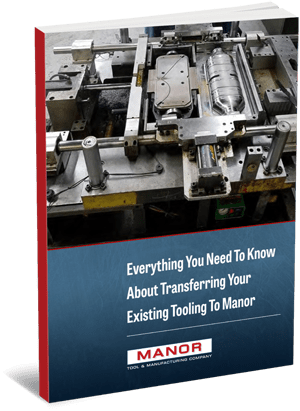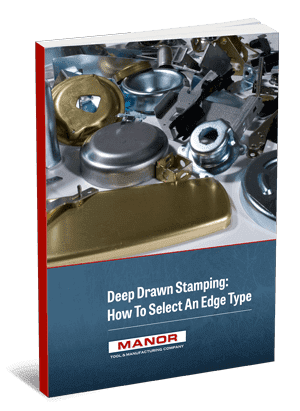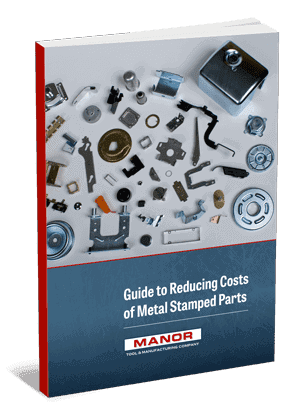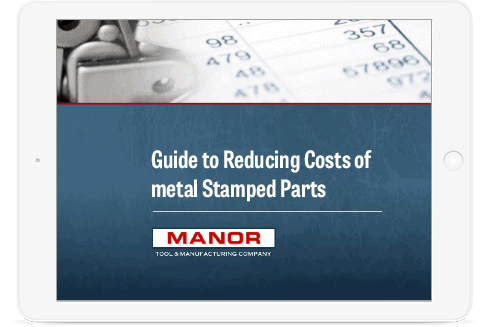The Materials Commonly Used for Metal Stamping & Fabrication
Manor Tool & Manufacturing Company is a full-service provider of precision metal stamping and deep drawing services in the Midwest. In a recent eBook (available for download here), we addressed some of the most commonly used metals and materials for metal stamping and the importance of choosing the right one for your project. Our material selection and cutting-edge fabrication techniques allow us to produce custom metal-stamped components for everything from sophisticated medical and aerospace equipment to large-scale fluid power, oil and gas, and original equipment manufacturer (OEM) projects.
Our success in the metal stamping field is driven in part by the quality of the starting materials we use for each stamping process. By providing our customers with an extensive selection of superior-quality metals, we help to ensure that each component is carefully optimized for its environment and application.
Materials Available From Manor Tool
To satisfy the needs of a diverse customer base, Manor Tool & Manufacturing offers the following material selection:
- Aluminum: Aluminum is a soft, non-metallic metal with a high strength-to-weight ratio, great formability, and good thermal and electrical conductivity. These features make it an excellent choice for creating metal stampings for aerospace, automotive, and construction applications requiring lightweight, high-strength components.
- Beryllium copper: Beryllium copper is a strong, corrosion-resistant copper alloy with a beryllium content ranging from 0.5 to 3%. With its high ductility, this alloy can be easily stamped into complex shapes with tight tolerances.
- Brass: Brass is a copper and zinc alloy known for its hardness, workability, and bright gold-like coloration. Its unique appearance and resistance to tarnishing and corrosion make it ideal for fabricating commercial and residential door hardware as well as automotive components.
- Carbon steel: Carbon steel is an iron and carbon alloy containing 2.1% carbon by weight. Low cost, high strength, and great solderability make carbon steel a popular choice for creating durable stamped brackets, vehicle panels, wear plates, and more.
- Copper: Copper is a soft, malleable metal with a distinct pinkish-orange appearance. A unique combination of electrical conductivity, durability, ductility, and corrosion resistance makes copper ideal for everything from stamped architectural features and decorative hardware to air conditioning components and medical parts.
- Additional alloys and superalloys: Metals like aluminum and copper can be alloyed with other metals or elements to create stamped components with improved strength and other enhanced properties. Superalloys include high-performance and specialty alloys such as Waspaloy and Monel. While somewhat harder to work with, stamped components made from superalloys can maintain their shape in a range of extreme environments.
- Stainless steel: Stainless steels are ferrous alloys containing various proportions of chromium, molybdenum, and nickel. With their excellent corrosion resistance, hardness, tensile strength, and temperature tolerance, stainless steel materials are well-suited for fabricating knives, cutting tools, to easy-to-clean medical appliances.
Our stainless steel options include:
-
- Type 301: ¼ Hard
- Type 301: ½ Hard
- Type 301: ¾ Hard
- Type 301: Full Hard
- Type 301: Extra Hard
- Type 302: Soft Annealed and Skin Passed
- Type 302: ¼ Hard
- Type 302: ¼ Hard
- Type 302: ¾ Hard
- Type 302: Full Hard
- Type 304: Soft Annealed and Skin Passed
- Type 304: Soft Annealed and Skin Passed
- Type 316: Soft Annealed and Skin Passed
- Type 321: Soft Annealed and Skin Passed
- Type 321: Soft Annealed and Skin Passed
- Type 410: Pre-Hardened and Tempered
- Type 420: Soft Annealed
- Type 430: Soft Annealed and Skin Passed
- 17/7-PH Condition A
- 17/7-PH Condition C
In addition to the extensive group of metals listed above, Manor Tool is equipped to stamp materials beyond the metals market. Call or contact us to discuss how we may be of service for your projects involving non-metals.
Manor Tool & Manufacturing has the equipment and experience to handle materials in a variety of compositions, including:
-
- Stainless
- Coiled
- Flat stock
- Extruded
- Thin material
- Tubing
- Wire
- Coated
- Perforated
- Polished
Which Metals are Best for Stamping?
When designing precision metal components, it is important to choose materials for metal stamping that are amenable to the stamping process while providing the functional and aesthetic characteristics required to support the application. Part of what makes metal stamping so versatile and widely used is its compatibility with thousands of different metals, all of which can be categorized as either ferrous or nonferrous:
- Ferrous: Ferrous metals have a significant proportion of iron in their elemental composition. One of the most commonly stamped ferrous metals is steel, an alloy primarily derived from iron ore. Ferrous metals containing higher amounts of carbon tend to be strong and brittle, while those with lower carbon content are softer and more ductile.
- Nonferrous: In contrast to ferrous metals, nonferrous metals lack appreciable amounts of iron in their composition. This makes them less susceptible to oxidation- or rust-induced deterioration. Examples of nonferrous materials used in metal stamping include copper, aluminum, brass, and bronze.
Both ferrous and nonferrous metals can be used to create alloys, which are metals that have been combined with at least one other metal or element. The resulting combination produces a material with a new set of physical, chemical, and mechanical properties that are generally superior to those exhibited by the parent material.
Key Properties
The properties of the chosen metal will strongly influence the performance of the stamped component in its environment. A few of the most important material properties to keep in mind when choosing a metal for your application include:
- Corrosion resistance: For components that will be exposed to moisture, atmospheric oxidation, or other corrosive conditions, choosing metal with an inherent resistance to corrosion is strongly recommended.
- Ductility: Ductility describes a metal’s ability to bend or change its physical form without breaking. This property is important for components that must be shaped into wires, threads, and other thin, elongated forms.
- Machinability: A metal’s machinability—or the ease with which it can be cut or shaped—will determine the quality and smoothness of the component’s surface finish once complete. Metals with good machinability are generally less expensive to process, while those that are more resistant to machining methods often require costly specialty tools or additional finishing steps to achieve the desired result.
- Tensile strength: Tensile strength measures the amount of stretching or pulling a metal can endure before cracking or undergoing irreversible deformation. This measurement is a good indication of how the stamped part will perform under various levels of tension.
- Weldability: Weldability describes the ability of a metal to be welded without producing defects. Metals with good weldability can be welded with minimal effort, while those with poor weldability may require special preparation steps and process modifications.
Stamping & Fabrication Services Available
At Manor Tool & Manufacturing, our primary in-house metal stamping services include:
- Metal stamping: Metal stamping is the process of cutting, piercing, or shaping sheet metal into various designs using a single stamping die or series of dies. The metal stamping process is highly cost-effective for large production runs and provides the versatility and precision to create complex, high-precision parts. This makes it ideal for stamping everything from durable connectors and washers for fluid power or oil and gas applications to high-precision components for sensitive aerospace and medical instruments.
- Deep drawn stamping: With deep drawn stamping, sheet metal is radially drawn into a die cavity by applying a punching force, facilitating the creation of a hollow axisymmetric design. This results in a highly accurate, strain-hardened part with no seams or joined sections. Deep drawn stamping is used to create precision medical device components, battery enclosures, and other high-strength cylindrical parts.
- Progressive die stamping: Progressive die stamping is a type of metal stamping in which the workpiece is continuously fed through a series of workstations, each of which performs a specific operation. By combining multiple operations into one process, progressive die stamping reduces labor and improves production efficiency. This process is often used to create highly accurate, repeatable stamped parts for automotive, electronics, and medical applications.
Precision Metal Stamping at Manor Tool & Manufacturing
With metal stamping, the quality and properties of the starting material are critical to the overall performance of the final product. At Manor Tool & Manufacturing, we offer an extensive selection of metals, alloys, and other specialty materials for metal stamping to help customers optimize their products for various applications and environments. Our in-house design and fabrication capabilities combined with our intensive quality inspections and extensive portfolio of secondary services allow us to create precise, high-quality components that meet strict technical specifications and industry requirements.
To learn more about the materials used in metal stamping and fabrication, please contact us, request a quote, or browse our collection of eBooks.








